Africa
Africa is the second-largest continent in the world with over 30 million people. Music plays an important role in the daily lives of its people. Only in certain regions is clay/mud employed in the making of musical instruments because of durability and access. In this exhibit, we find drums and rattles from Northern and Central Africa. Their shape, form, and potential functions represent associations with cultural practices.
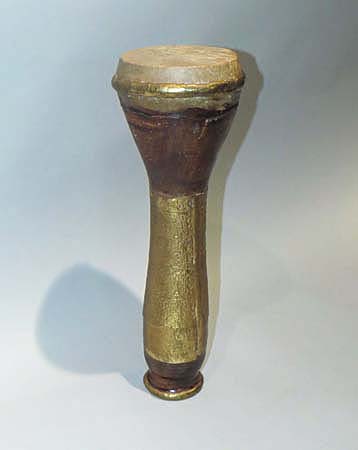
Tara’ij Hand Drum #1
Morocco
Clay, hide, metal
1950s
Tarija is a small goblet-shaped, single-skin, tube drum used in the Melhoun genre of Moroccan art music. The clay is glazed and painted a dark brown/bronze color with some small linear etching, and the embossing is a floral pattern. The rim has a metal ring to secure the goat skin.
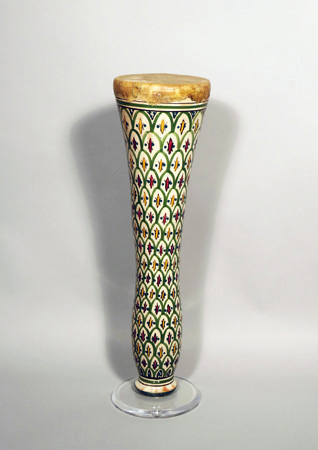
Tara’ij Hand Drum #2
Morocco
Clay, hide
1950s
This shoulder drum called tarija has a skin head and a glazed body with colorful leafed designs. The bottom of the drum is tapered, with a slightly flared rim. In some areas, tara’ij are traditionally given to children during the Islamic holiday of Ashura. A boy’s drum has a plain baked-clay tube, and a girl’s drum is painted in brightly colored patterns.
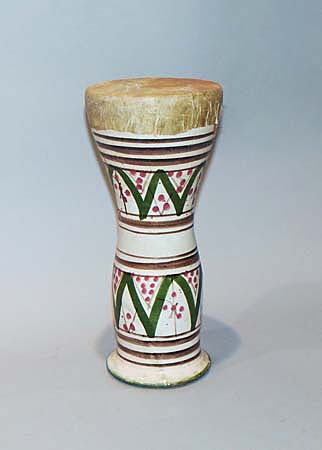
Tara’ij Hand Drum #3
Morocco
Clay, hide
1960s
This small drum called tarija has a skin head and a glazed body with colorful dot and geometric designs. The bottom of the drum is tapered, with a slightly flared rim. In some areas, tara’ij are traditionally given to children during the Islamic holiday of Ashura. A boy’s drum has a plain baked-clay tube, and a girl’s drum is painted in brightly colored patterns.
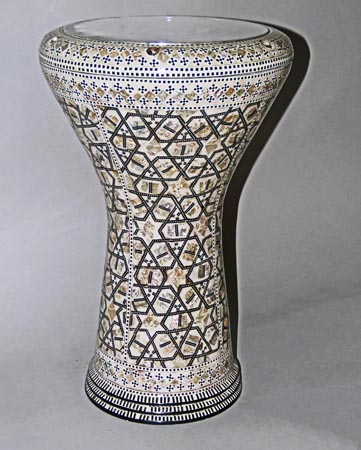
‘Doumbek’
Egypt
Terracotta
1950s
This is the classic design of an Egyptian handmade doumbek, made by Gawharet El Fan in Egypt. The doumbek, originally made of clay with fish or goat skin head, is one of the most iconic percussion instruments used in middle eastern and Northern Africa music.
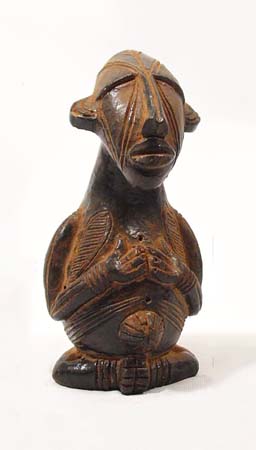
Tikar Rattle #1
Cameron
Terracotta
1950s
The grassland region in Southwest Cameroon is one of the most artistically rich areas of Africa. Only 250,000 Tikar people remain. They believe that these small terra cotta house gods serve as symbols for protection, fertility, and power. This Tikar terra cotta rattle depicts a figure gesturing with his hands, a plea for good health.
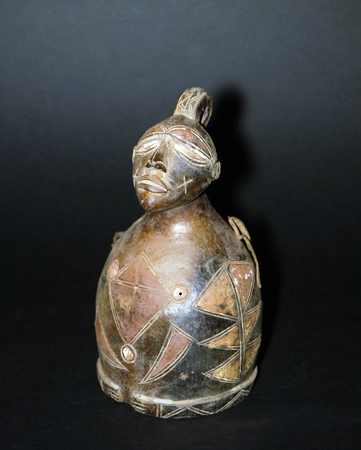
Tikar Rattle #2
Cameron
Terracotta
1950s
This rattle comes from the Tikar people of Cameroon grasslands. The Tikar have produced these clay figures to represent the spirits of the first occupants of their region. Such clay figures are known as house gods.

‘Clapper Drum’
Tunisia
Clay, hide
1970s
This small clay clapper drum is made of a small vessel-shaped body with two small skin heads tied over the side openings with a light green thread. One end of the instrument forms a handle and the other has a hole through which a small clay clapper bead is attached to a white thread. The instrument is played by shaking up and down so the membranes are hit by the clapper.
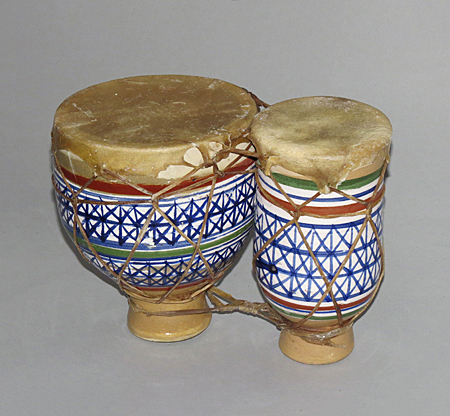
‘Naqqara’
Morocco
Clay, hide
1950s
The naqqara is a type of kettledrum of the Islamic world, used among the Tuareg of the Sahara. This naqqara pair from Morocco, consist of a large and a small kettle drum, laced together with gut/sinew, with each tuned to different pitches. Variant names and uses of the naqqara in North Africa, include the nuqayra of the north African Berbers and Syrians and the nagarit which is widely use in Ethiopian military and religious music.
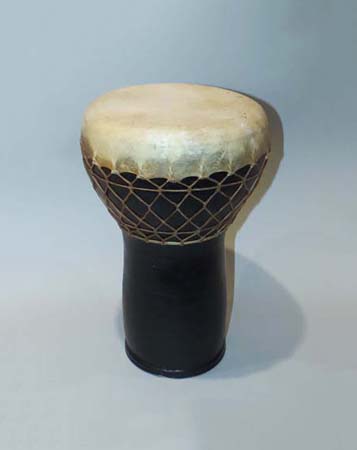
‘Darbuka’ #1
Egypt
Clay, goat skin, fiber string
1940s
This Egyptian hand drum is a folk instrument with a round head (unlike the Turkish with exposed edges) tuned by stretching the goat skin with netting over the top of the goblet-shaped glazed pottery body. The origin of the term darbuka is somewhat obscure but probably lies in the Arabic word darba (to strike), or durub (rhythmic cycles) Hence, darbuka could mean, your strike, or your rhythm.

‘Sakara’ (Omele oko)
Yoruba People of Southwestern Nigeria
Clay, goat skin, wood
1940s
Drumming is a vital part of the Yoruba people in southwestern Nigeria. This shallow drum of the Yoruba is known as a ‘sakara’ drum, but it is called ‘omele oko’ by the Yoruba people. It has a circular body made with baked clay, a goat skin for the head of the drum while spaced wooden pegs around its body are used for tuning. The omele oko is used during wedding ceremonies, traditional coronations, and festivals. It is played by striking the drumhead with a wooden straight stick in one hand while the other hand supports the drum in a vertical position, on the top of the leg while sitting. The fingers of the supporting hand are used to mute the drumhead to create variations in sound.
